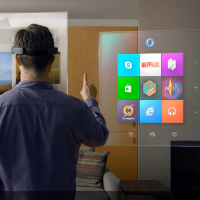Instead of Texting, Send a Hologram

“Help me, Obi-Wan Kenobi. You’re my only hope.”
Of course Princess Leia used hologram technology when she wanted to send an important message. She pleaded for Obi-Wan’s help against the Empire in a hologram stored in R2-D2 in Star Wars Episode IV: A New Hope. Along with audiences everywhere back in 1977, Luke Skywalker was enthralled. Fast forward to 2015, and it finally looks like the technology is advancing to where the rest of us may finally be able to use holograms in our everyday lives.
At the recent Microsoft’s Windows 10 event, one of the more intriguing technology announcements was a head-mounted holographic computer: Microsoft HoloLens. According to Microsoft, the headset will let the wearer blend the digital world with the real world to conceptualize and share ideas. “There isn’t a screen to touch or a mouse to click. Use gestures to create, shape, and size holograms. Use your eyes to navigate and explore. Use your voice to communicate with your apps.”
If it sounds like science fiction, here’s the definition from Microsoft:
A hologram is an object like any other object in the real world, with only one difference: instead of being made of physical matter, a hologram is made entirely of light. Holographic objects can be viewed from different angles and distances, just like physical objects, but they do not offer any physical resistance when touched or pushed because they don’t have any mass. Holograms can be two-dimensional, like a piece of paper or a TV screen, or they can be three-dimensional, just like other physical objects in your real world. The holograms you’ll see with Microsoft HoloLens can appear life-like, and can move, be shaped, and change according to interaction with users or the physical environment in which they are visible.
For a fascinating look last year in the “secret basement lab” at Microsoft where the holographic goggles were developed, Wired features an interview with the chief architect of the project, Alex Kipman, and a demo of the prototype. “Kipman’s prototype is amazing,” wrote Wired’s Jessi Hempel.
Who wants one? Researchers at NASA’s Jet Propulsion Laboratory in Pasadena, California are already working with Microsoft on software called OnSight that uses the HoloLens technology. Scientists will be able to use actual rover Curiosity data to create a 3-D simulation of the environment on Mars. Testing the technology in Curiosity mission operations is slated for later this year.
A general public release date hasn’t been officially announced for HoloLens, and, realistically, we probably won’t be participating in Jedi Council-like holographic meetings any time soon. But it does appear to be on the horizon. Holographic messages, instead of texting? How cool would that be?

